Membranipora membranacea (Linnaeus, 1767)Common name(s): Kelp encrusting bryozoan, Lacy crust bryozoan, Kelp lace bryozoan, Encrusting bryozoan |
|
| Synonyms: Flustra membranacea | 
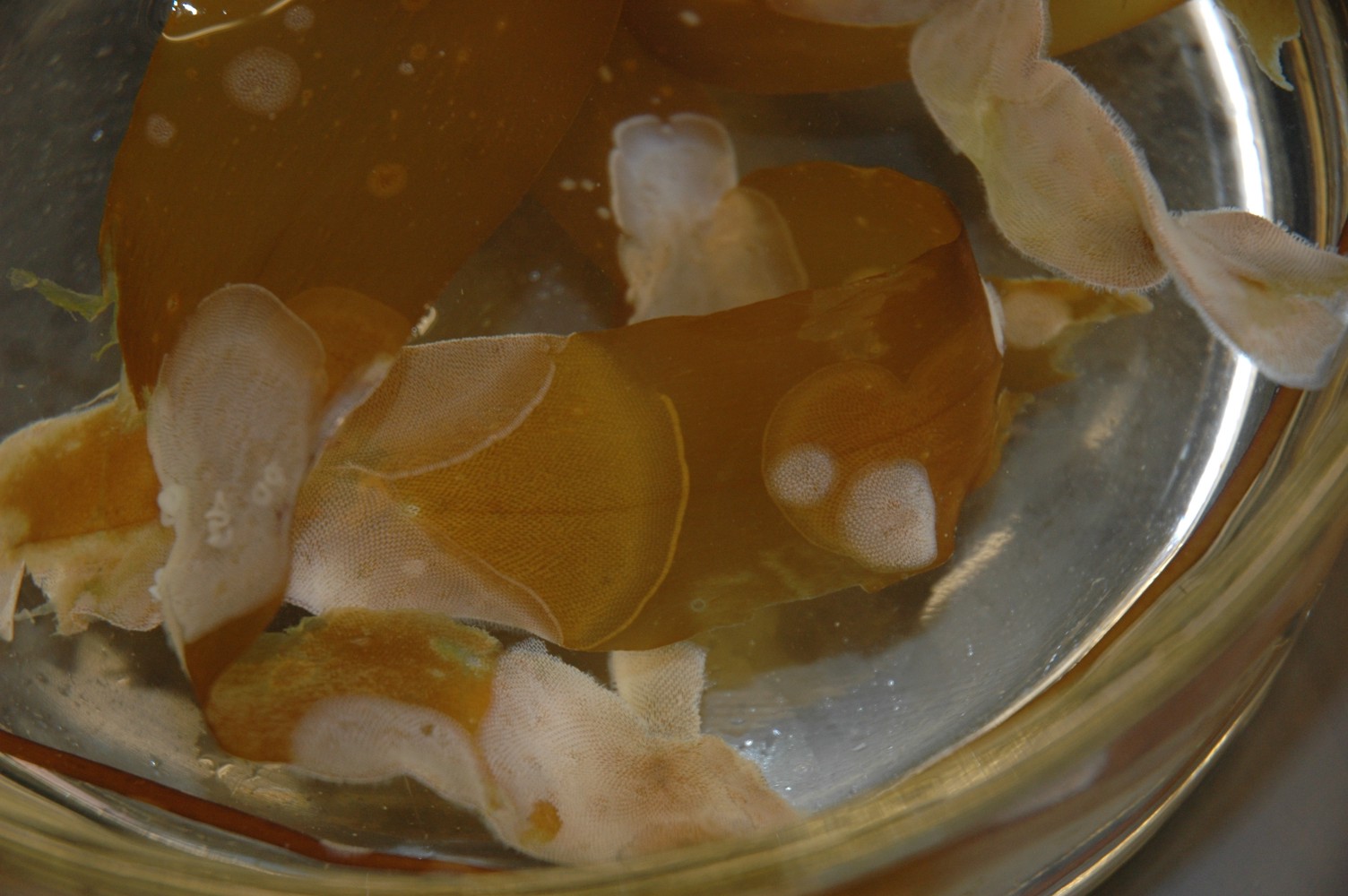 |
|
Phylum
Bryozoa (Ectoprocta)
Class Gymnolaemata
Suborder Anasca
Family Aeteidae
|
|
| Membranipora membranacea bryozoans on a Nereocystis float and blades. | |
| (Photo by: Dave Cowles, July 2007) | |
Note: There are at least three Membranipora species which have been commonly identified on kelp along our coast: M. membranacea, M. tuberculata, and M. villosa. M. tuberculata and M. villosa have spines while M. membranacea does not. However, grazing by nudibranchs is now known to induce spines on M. membranacea and it is possible that the two other species are simply M. membranacea which has had spines induced by grazing. Others say that M. membranacea is an Atlantic species and the species here is M. villosa.
How to Distinguish from Similar Species: Although Conopeum reticulum also grows as thin, flat crusts with rectangular zooids and no avicularia, the walls between zooecia are heavily calcified and granular. The California spiral-tufted bryozoan, Bugula californica, may also grow on kelp blades but it does not form a crust.
Geographical Range: All world temperate zones. In the Eastern Pacific, from Alaska to Baja California. It is apparently not native in the North Atlantic.
Depth Range: Intertidal to shallow subtidal
Habitat: Usually on kelp fronds. May also be on floats or rocks.
Biology/Natural History: Bryozoans start from a single individual zooid (an ancestrula) which repeatedly reproduces asexually to form a colony. In this species, the oldest individual is in the middle. Colonies of this species usually begin to be noticeable in late spring and grow through summer into fall. By fall they may form extensive crusts on the kelp and many colonies have merged with one another. In many bryozoans there are various types of zooids but in this species there is only one type of zooid which serves for feeding, for reproduction, and for defense. The colony appears to be a simultaneous hermaphrodite, or male zooids may develop first. They do not brood their young. Eggs are fertilized then released, and quickly develop into cyphonautes larvae which may feed and develop as plankton for several months. The larvae settle when they encounter kelp such as Laminaria or water with an excess of potassium ions. The small white nudibranch Doridella steinbergae may be found living and feeding on these colonies but it blends in so well it is difficult to see. Other predators include sea urchins and the nudibranch Corambe pacifica (pale translucent gray with a central yellowish patch and marginal yellow lines, up to 1 cm long, nearly as wide as long, with a deep notch in back). Colonies which have recently been attacked by nudibranchs may grow large chitonous spines, especially on the peripheral zooids.
This species appears to be able to feed at higher water flow
velocities
than some other species can (Pratt,
2008). They frequently encrust the brown
kelp Nereocystis
luetkeana, and the larvae show a strong preference to
settling on
that alga over the red alga Mazzaella
splendens (Matson
et al., 2010). The Matson et al. article includes
online several
videos showing larval settlement in flow.
| Return to: | |||
| Main Page | Alphabetic Index | Systematic Index | Glossary |
References:
Dichotomous Keys:Flora and Fairbanks, 1966
Kozloff 1987, 1996
Smith and Carlton, 1975
General References:
Harbo,
1999
Johnson
and Snook, 1955
Kozloff,
1993
McConnaughey
and McConnaughey, 1985
O'Clair
and O'Clair, 1998
Ricketts
et al., 1985
Scientific Articles:
Deburgh, M.E. and P.V. Frankboner, 1978. Nutritional
association
between bull kelp, Nereocystis leutkeana and its epizooic
bryozoan Membranipora
membranacea. Oikos 31: pp 69-72
Dixon, J. S.C. Schroeter, and J. Kastendiek, 1981. Effects of the encrusting bryozoan, Membranipora membranacea, on the loss of blades and fronds by the giant kelp, Macrocystis pyrifera (Laminariales). Journal of Phycology 17: pp 341-345
Matson, Paul G., Benjamin T. Steffen, and Richard M. Allen, 2010. Settlement behavior of cyphonautes larvae of the bryozoanMembranipora membranacea in response to two algal substrata. Invertebrate Biology 129:3 pp 277-283
Pratt, Marney C., 2008. Living where the flow is right: How flow affects feeding in bryozoans. Integrative and Comparative Biology 48:6 pp 808-822
Saunders, Megan I, Anna Metaxas, and Ramon Filgueira, 2010. Implications of warming temperatures for population outbreaks of a nonindiginous species (Membranipora membranacea, Bryozoa) in rocky subtidal ecosystems. Limnology and Oceanography 55:4 pp 1627-1642
Ruiz, Gregory M., James T. Carlton, Edwin D. Grosholz, and Anson H. Hines, 1997. Global invasions of marine and estuarine habitats by non-indiginous species: mechanisms, extent, and consequences. American Zoologist 37:6 pp. 621-632
Stricker, S.A., 1989. Settlement and metamorphosis of the marine bryozoanMembranipora membranacea. Bulletin of Marine Science 45: pp 387-405
Wollacott, Robet M. and Wheeler J. North, 1971. Bryozoans of California and northern Mexico kelp beds. pp. 455-479 in North, Wheeler J. (ed.), The Biology of Giant Kelp Beds (Macrocystis) in California. Beihefts zur Nova Hedwigia Heft 32. Publisher: J. Cramer, Lehre, Germany./span>
Yoshioka, P.M.,
1982. Role of planktonic
and benthic factors in the population dynamics of the
bryozoan, Membranipora
membranacea. Ecology 63: pp 457-468
Web sites:
General Notes and Observations: Locations, abundances, unusual behaviors:
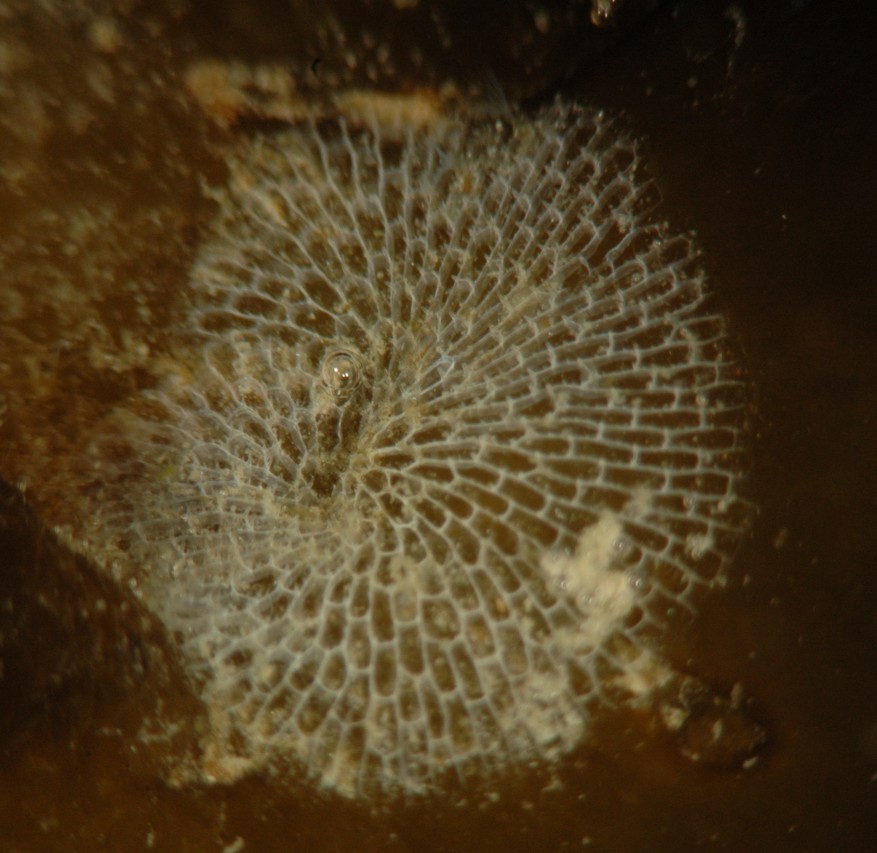
A closer view of one of the colonies shows the lacelike latticework
of the boxlike zooecia.
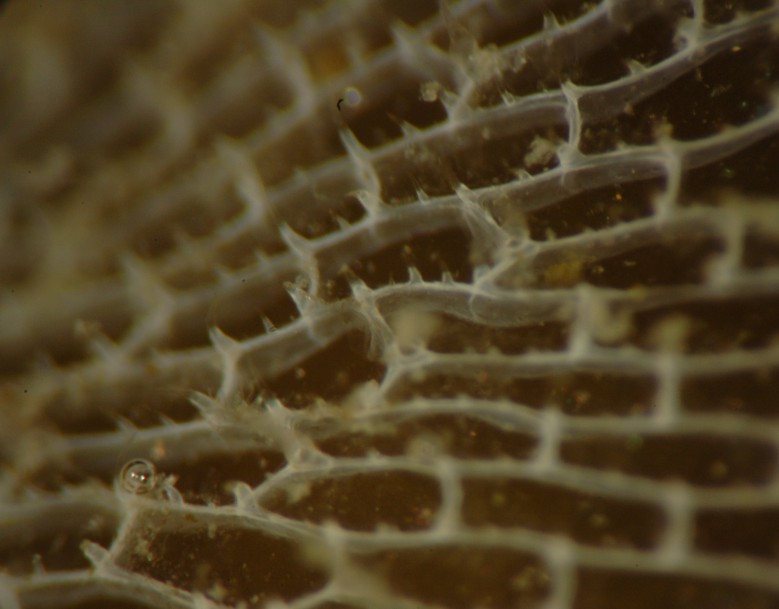
This closer view of the same colony as above shows the small spines
present around some of the zooids.
Perhaps this colony has been attacked by nudibranchs lately.
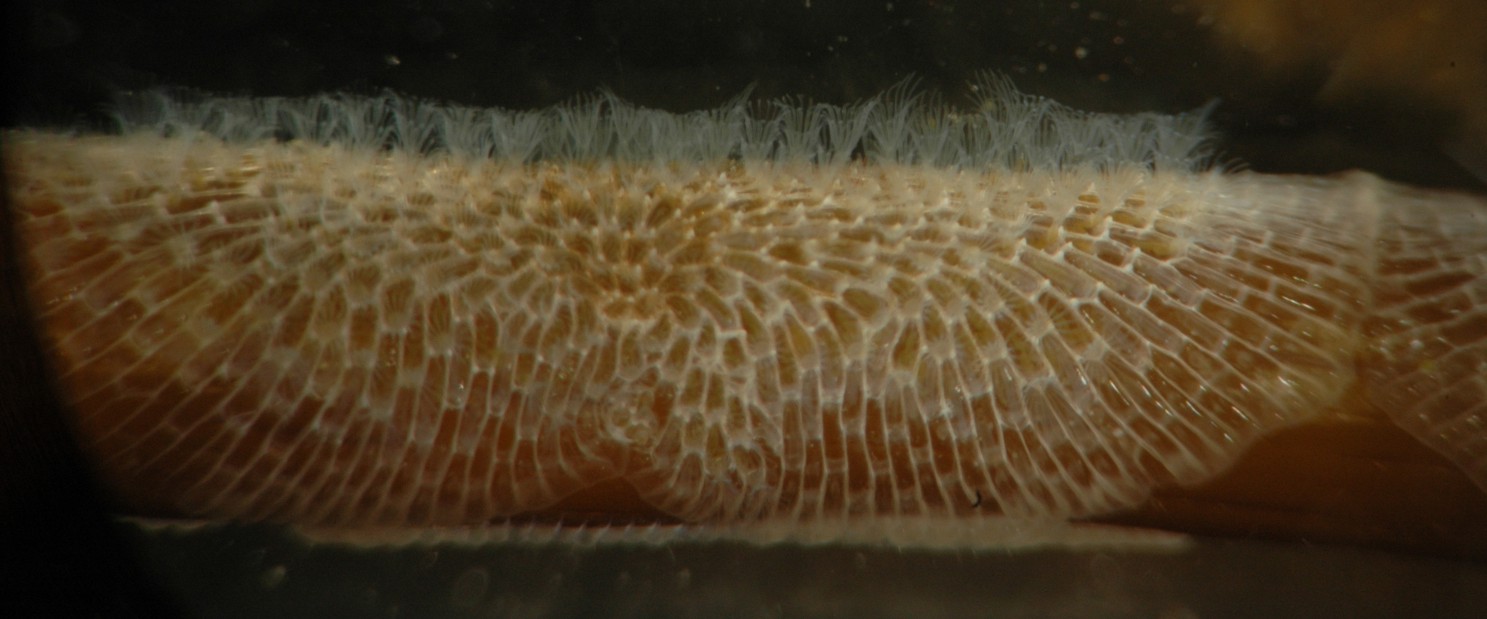
This closeup view of a colony wrapped around a tiny Nereocystis stipe
shows the feeding zooids
with their lophophores
extended in the feeding position.
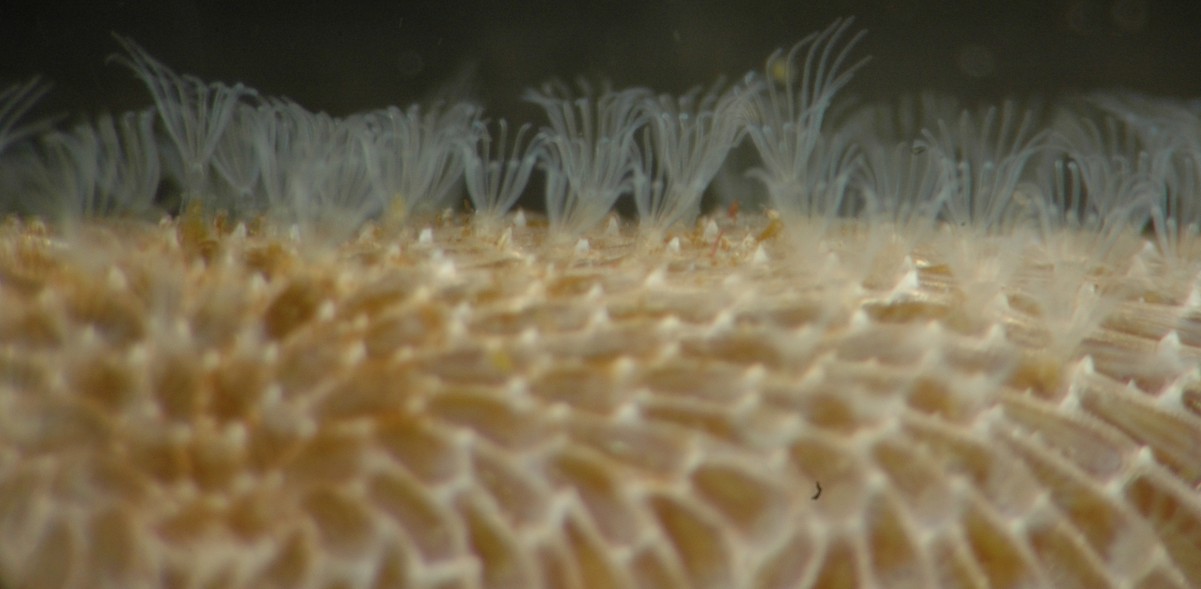
Here is a closer view of the lophophores.
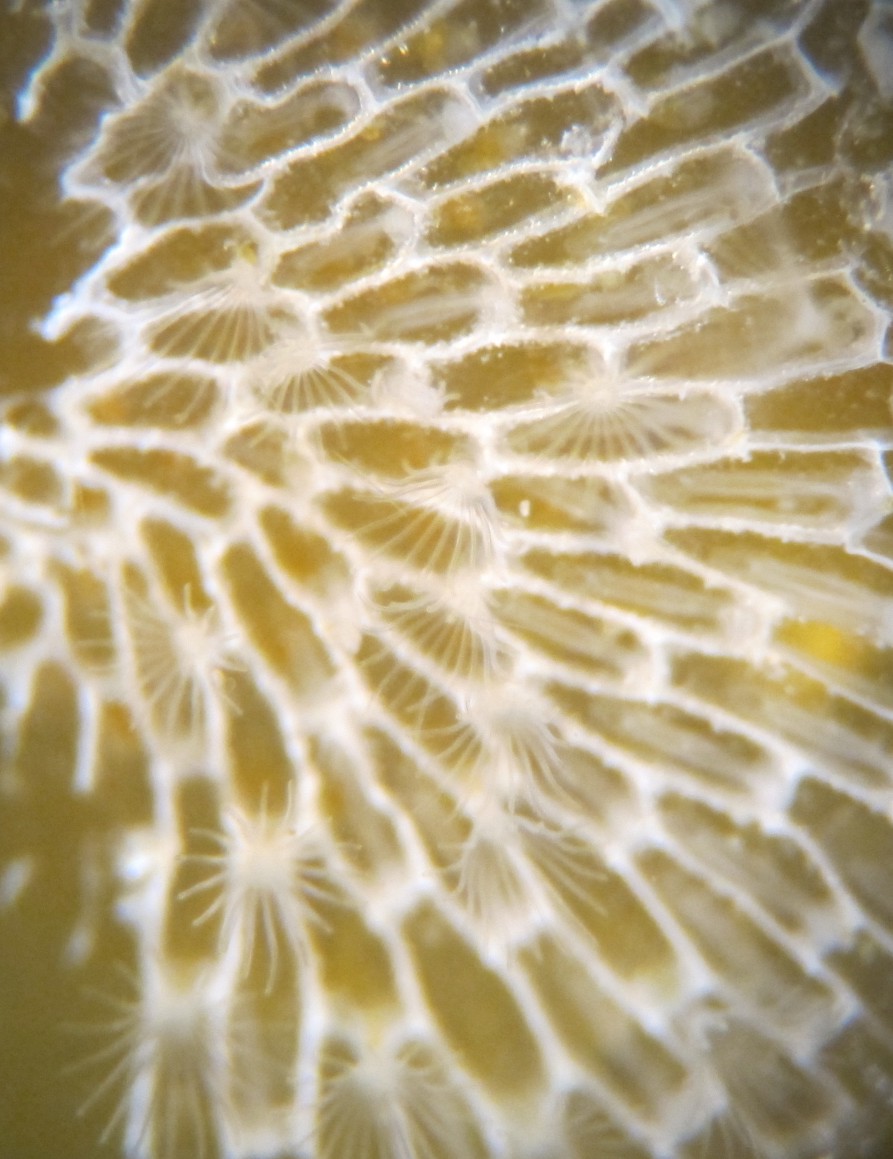
A view of the open lophophores
from above. Photo 2011 by Brianna Payne
Authors and Editors of Page:
Dave Cowles (2007): Created original page
Jonathan Cowles (2007): Updated page with CSS